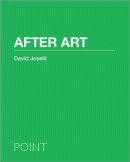After Art shifts critical emphasis from art’s production (and the corollary of artistic intention) to what images do once they enter circulation in heterogeneous networks.
Diagram 1. Designed by Geoff Kaplan. 
There are three dominant attitudes toward images that parallel those pillars of grade school education—reading, writing, and ’rithmetic—with three Ds: derivative, dumb, and deceptive.
• Derivative: Images are thought to derive significance from external sources. Whether tethered to a historical era or a philosophical idea, they are treated as illustrations—as vessels for borrowed content.
• Dumb: Images are dismissed as merely intuitive—incapable of the rigorous formalization that transforms visual data into communicable knowledge. In an otherwise excellent book by Ian F. McNeely with Lisa Wolverton, Reinventing Knowledge: From Alexandria to the Internet, for instance, art is considered a form of “informal knowledge.” In their preface McNeely and Wolverton state, “[Our book] hardly touches on informal knowledge, the type of knowledge we get from reading a newspaper, fixing a motorcycle, parenting a child, or creating a work of art.”[1] The (widely shared) assumption of these authors is that visual intelligence is insufficiently disciplined to cross the threshold of “formal” (i.e., genuine) knowledge.
• Deceptive: As sources of pleasure, images deceive. They create the ideological fantasias that Guy Debord so lustily condemned in his 1967 manifesto, The Society of the Spectacle, and that critics from both the right and the left have loved to hate ever since. As spectacle, images are the opposite of knowledge—they are the epitome of ignorance.[2]
After Art will assert that images possess vast power through their capacity for replication, remediation, and dissemination at variable velocities. In order to exploit this power for progressive ends, it is necessary to understand the potency of images on their own terms rather than dismissing them as derivative, dumb, and deceptive. To this purpose, After Art will shift critical emphasis from art’s production (and the corollary of artistic intention) to what images do once they enter circulation in heterogeneous networks. While the prefix after signifies belatedness, it is not synonymous with the more commonly used prefix post, which, as in the vexed category postmodern, or its more recent successor, postmedium, indicates both the termination and transformation of a previous era and its signature styles.[3] Post leaves the art object in tact albeit transformed or negated, whereas after shifts emphasis to its effects—its power—under the conditions of circulation.
The term image is a slippery one. I will use it here to indicate a quantum of visual content (say a digital photograph) that can assume a variety of formats.[4] For instance, any digital photograph may remain a computer file, or be printed in a variety of ways on a variety of surfaces; it lends itself to editing with software like Photoshop, and it can be degraded in quality by emailing or uploading it. In short, an image is a visual byte, vulnerable to virtually infinite remediation. The icon that heads this preface, which appears in a sequence of diagrams punctuating After Art, was designed by Geoff Kaplan to signify a new, more productive understanding of the power of images. Here are three of its aspects:
• Eye and I: the letter i in the center of the icon suggests both a pupil and a pronoun, just as images combine sensory and conceptual forms of information that, together, constitute their connection or link with spectators.
• Scalability and transformation: Images are a form of information that may shift from two dimensions to three, from tiny to huge, or from one material substrate to another, just as the image-icon in this book will move through several formats or situations in its sequence of diagrams.
• Power and currency: The icon approximates a plug where the i functions as a prong entering a disk. I will argue that images produce power—a current or currency—that is activated by contact with spectators. The more points of contact an image is able to establish, the greater its power will be.
[1] Ian F. McNeely with Lisa Wolverton, Reinventing Knowledge: From Alexandria to the Internet (New York: Norton, 2008), xv.
[2] See Guy Debord, The Society of the Spectacle, trans. Donald Nicholson-Smith (New York: Zone Books, 1995). One of very many examples of “the spectacle” being taken as a monolithic force by critics on the left is Retort (Iain Boal, T. J. Clark, Joseph Matthews), and Michael Watts, Afflicted Powers: Capital and Spectacle in a New Age of War, new ed. (London: Verso, 2006).
[3] See Rosalind E. Krauss, A Voyage on the North Sea: Art in the Age of the Post-Medium Condition (New York: Thames and Hudson, 2000).
[4] Arguably the most influential definitions of an image as the term is used currently in art history are those of Hans Belting and W.J.T. Mitchell. In Likeness and Presence, Belting states his definition explicitly in the Foreword: “[I]n the framework of this book, the image I am considering is that of a person, which means that I have chosen one of several possibilities. The image, understood in this manner, not only represented a person but was also treated like a person, being worshiped, despised, or carried from place to place in ritual processions: in short, it served in the symbolic exchange of power and, finally, embodied the public claims of a community.” Likeness and Presence: A History of the Image before the Era of Art, trans. Edmund Jephcott (Chicago: University of Chicago Press, 1994), xxi. I would like to underline two ramifications of this argument beyond the important qualification of the image as the representation of a person: First, according to Belting this image is historically specific. It is the type of visual entity that exists before the modern understanding of art, or what he calls the “era of art.” In other words it pertains to visual culture before the Renaissance. Second, this image is known through its “agency” as well as through the acts and aspects attributed to it by different constituencies (such as theologians, but also how images were used and abused popularly).
In Iconology, Mitchell, on the other hand, is at pains to insist that the image is culturally specific (though not necessarily pre-modern as in Belting’s definition) and that it may be situated in a variety of disciplines, ranging from theology to literature, to science, to art, where it has significantly different meanings. This is what he calls a rigorous relativism. As different as these accounts seem on the surface they share two important qualities: first, that the image is based in history (though Belting periodizes it whereas Mitchell pluralizes it), and that the image possesses agency. Mitchell writes, “Images are not just a particular kind of sign, but something like an actor on the historical stage, a presence or character endowed with legendary status, a history that parallels and participates in the stories we tell ourselves about our own evolution from creatures ‘made in the image’ of a creator, to creatures who make themselves and their world in their own image.” W.J.T. Mitchell, Iconology: Image, Text, Ideology (Chicago: University of Chicago Press, 1986), 9.
My definition of the image transposes these two fundamental qualities—historical specificity and agency—into terms relevant to a digital and global era of wild image proliferation. I will dwell on questions of remediation (or format) in the place of historical specificity; with regard to agency, I will argue that populations of images exercise the kind of power that Belting and Mitchell differently locate in the image as personage.



